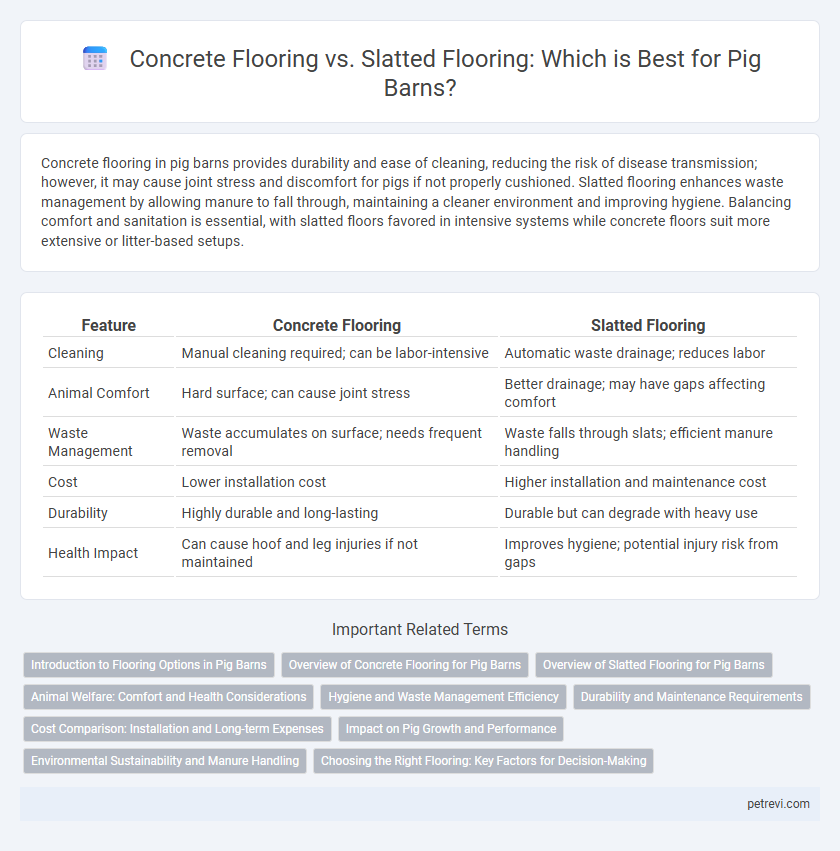Concrete flooring in pig barns provides durability and ease of cleaning, reducing the risk of disease transmission; however, it may cause joint stress and discomfort for pigs if not properly cushioned. Slatted flooring enhances waste management by allowing manure to fall through, maintaining a cleaner environment and improving hygiene. Balancing comfort and sanitation is essential, with slatted floors favored in intensive systems while concrete floors suit more extensive or litter-based setups.
Table of Comparison
| Feature | Concrete Flooring | Slatted Flooring |
|---|---|---|
| Cleaning | Manual cleaning required; can be labor-intensive | Automatic waste drainage; reduces labor |
| Animal Comfort | Hard surface; can cause joint stress | Better drainage; may have gaps affecting comfort |
| Waste Management | Waste accumulates on surface; needs frequent removal | Waste falls through slats; efficient manure handling |
| Cost | Lower installation cost | Higher installation and maintenance cost |
| Durability | Highly durable and long-lasting | Durable but can degrade with heavy use |
| Health Impact | Can cause hoof and leg injuries if not maintained | Improves hygiene; potential injury risk from gaps |
Introduction to Flooring Options in Pig Barns
Concrete flooring in pig barns offers durability, ease of cleaning, and excellent waste containment, crucial for maintaining hygiene and reducing disease risk. Slatted flooring improves manure drainage and ventilation by allowing waste to fall through gaps, enhancing animal comfort and barn sanitation. Choosing the right flooring impacts pig health, labor efficiency, and overall barn management in intensive swine production systems.
Overview of Concrete Flooring for Pig Barns
Concrete flooring in pig barns offers durability, ease of cleaning, and effective waste management, making it a popular choice for housing pigs. It provides a solid, non-slippery surface that supports pig health by reducing injuries and facilitating proper drainage when sloped correctly. Proper installation and maintenance of concrete floors enhance barn biosecurity by minimizing pathogen buildup and improving overall sanitation.
Overview of Slatted Flooring for Pig Barns
Slatted flooring for pig barns consists of durable, non-slip panels with narrow gaps that allow manure to fall through, enhancing waste management and barn hygiene. This flooring type improves air quality by reducing ammonia buildup and provides pigs with a dry, comfortable surface that supports hoof health and reduces injury risk. Slatted floors require less frequent cleaning compared to concrete, leading to lower labor costs and improved overall barn efficiency.
Animal Welfare: Comfort and Health Considerations
Concrete flooring in pig barns offers durability and ease of cleaning but can lead to joint stress and discomfort, increasing the risk of lameness and injuries. Slatted flooring improves waste management by allowing manure to fall through, reducing moisture and ammonia levels, which enhances air quality and reduces respiratory issues. Providing adequate bedding material on slatted floors is crucial to prevent hoof damage and improve overall pig comfort and welfare.
Hygiene and Waste Management Efficiency
Concrete flooring in pig barns provides a solid, easy-to-clean surface that reduces the buildup of bacteria and pathogens, enhancing overall hygiene. Slatted flooring allows manure to fall through directly into waste channels, improving waste management efficiency and minimizing pigs' contact with feces and urine. Choosing the appropriate flooring impacts disease control and labor intensity in waste removal, crucial factors for maintaining a healthy pig environment.
Durability and Maintenance Requirements
Concrete flooring in pig barns offers high durability with resistance to heavy wear, but it requires regular cleaning and occasional repairs to prevent cracks and maintain hygiene. Slatted flooring, typically made of plastic or metal, provides easier waste removal and reduces maintenance time, though it may wear faster under heavy traffic and requires periodic inspections for damage. Choosing between concrete and slatted flooring depends on balancing long-term durability with the specific maintenance demands of the pig barn environment.
Cost Comparison: Installation and Long-term Expenses
Concrete flooring in pig barns requires higher initial installation costs due to materials and labor but offers durability and easier cleaning that can reduce long-term maintenance expenses. Slatted flooring, often made of plastic or metal, has lower upfront costs and improves waste drainage, potentially decreasing manure management costs but may incur higher replacement and repair expenses over time. Evaluating total lifecycle costs, including installation, durability, maintenance, and pig welfare impacts, is essential for cost-effective flooring selection in pig housing.
Impact on Pig Growth and Performance
Concrete flooring offers a durable surface that supports consistent pig growth rates by providing stable footing and reducing injury risks, yet it can cause discomfort and joint issues if not properly maintained. Slatted flooring enhances hygiene and waste management, promoting better respiratory health and feed conversion efficiency, which positively affects pig performance. However, slatted floors may lead to hoof damage and stress if spacing and material are not optimized for pig weights and sizes.
Environmental Sustainability and Manure Handling
Concrete flooring in pig barns offers durability and ease of cleaning but often leads to increased water usage and challenges in effective manure separation, impacting environmental sustainability. Slatted flooring systems enhance manure handling by allowing waste to fall directly into collection pits, reducing ammonia emissions and minimizing water contamination risks. These systems promote better nutrient management and lower greenhouse gas emissions, contributing to improved environmental outcomes in pig farming.
Choosing the Right Flooring: Key Factors for Decision-Making
Concrete flooring in pig barns offers durability and ease of cleaning, making it suitable for heavier pigs and high-traffic areas, while slatted flooring improves manure management by allowing waste to fall through, reducing labor and promoting hygiene. Key factors in choosing between these options include pig age and size, ventilation and drainage requirements, and budget considerations for installation and maintenance. Optimizing flooring choice enhances animal welfare, growth performance, and overall barn efficiency.
Concrete flooring vs Slatted flooring for Pig barn Infographic

 petrevi.com
petrevi.com